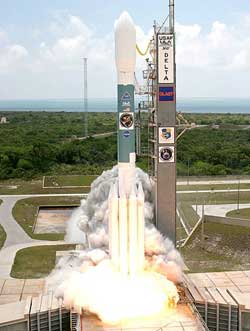Imagine the Universe News - 12 June 2008
NASA's GLAST Launch Successful
| 12 June 2008 |
NASA's Gamma-ray Large Area Space Telescope, or GLAST, successfully launched aboard a Delta II rocket from Cape Canaveral Air Force Station in Florida at 12:05 p.m. EDT on June 11.
 Click on image for larger version. |
| The GLAST spacecraft and Delta II rocket leap off the launch pad. (Credit: Carleton Bailie for United Launch Alliance) |
After a 75-minute flight, the GLAST spacecraft was deployed into low Earth orbit. It will begin to transmit initial instrument data after about three weeks. The telescope will explore the most extreme environments in the universe, searching for signs of new laws of physics and investigating what composes mysterious dark matter. It will seek explanations for how black holes accelerate immense jets of material to nearly light speed, and look for clues to crack the mysteries behind powerful explosions known as gamma-ray bursts.
"After a 60-day checkout and initial calibration period, we'll begin science operations," said Steve Ritz, GLAST project scientist at Goddard. "GLAST soon will be telling scientists about many new objects to study, and this information will be available on the internet for the world to see."
NASA's GLAST mission is an astrophysics and particle physics partnership, developed in collaboration with the U.S. Department of Energy, along with important contributions from academic institutions and partners in France, Germany, Italy, Japan, Sweden and the U.S.

